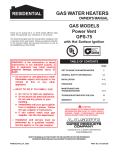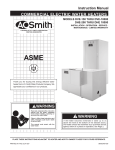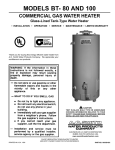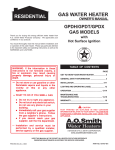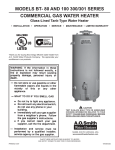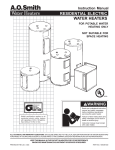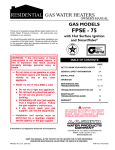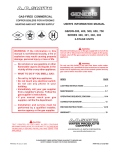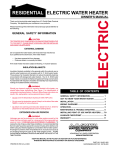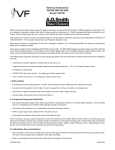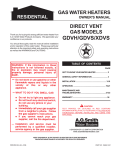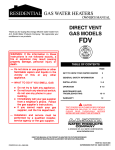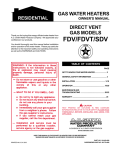Download A.O. Smith 184769-000 Owner`s manual
Transcript
GAS WATER HEATER OWNER'S MANUAL GAS RESIDENTIAL Thank you for buying this energy efficient water heater from A.O. Smith Water Products Company. We appreciate your confidence in our products. You should thoroughly read this manual before installation and/or operation of this water heater. Please pay particular attention to the important safety and operating instructions as well as the WARNINGS and CAUTIONS. TABLE OF CONTENTS PAGE GET TO KNOW YOUR WATER HEATER 2 GENERAL SAFETY INFORMATION 3 INSTALLATION 4 -6 OPERATION 6 -8 MAINTENANCE AND TROUBLESHOOTING 8 -10 WARRANTY 11 CAUTION TEXT PRINTED OR OUTLINED IN RED CONTAINS INFORMATION RELATIVE TO YOUR SAFETY. PLEASE READ THOROUGHLY BEFORE INSTALLING AND USING THIS APPLIANCE. A DIVISION OF A.O. SMITH CORPORATION www.aosmithwaterheaters.com KEEP THIS MANUAL IN THE POCKET ON HEATER FOR FUTURE REFERENCE WHENEVER MAINTENANCE ADJUSTMENT OR SERVICE IS REQUIRED. PRINTED IN U.S.A. 0104 1 PART NO. 184769-000 GET TO KNOW YOUR WATER HEATER REPLACEMENT PARTS AND DELIMING PRODUCTS (A) (B) (C) (D) Replacement parts and recommended delimer may be ordered through authorized servicers or distributors. Refer to the Yellow Pages for where to call or contact A.O. Smith Water Products Company, 5621 W. 115th Street, Alsip, Illinois 60803, 1-800-433-2545. When ordering parts, provide complete model and serial numbers (see rating plate), quantity and name of part desired (as listed in Figure 1). Standards hardware items may be purchased locally. (E) (F) (G) (H) (J) (K) (L) (M) *INSTALL IN ACCORDANCE WITH LOCAL CODES. VENT PIPE DRAFT HOOD ANODE HOT WATER OUTLET OUTLET INSULATION GAS SUPPLY MANUAL GAS SHUT OFF VALVE GROUND JOINT UNION DIRT LEG INNER DOOR OUTER DOOR (N) UNION O) INLET WATER SHUT OFF VALVE (P) COLD WATER INLET (Q) INLET DIP TUBE (R) TEMPERATURE AND PRESSURE RELIEF VALVE (S) RATING PLATE (T) FLUE BAFFLE (U) THERMOSTAT (V) DRAIN VALVE (W) PILOT AND MAIN BURNER (X) FLUE (Y) DRAIN PAN (U) THERMOSTAT CERTAIN MODELS ARE EQUIPPED WITH SIDE PLUMBING CONNECTIONS FOR SPACE HEATING. THE HOT AND COLD FITTING ASSEMBLIES (PART #900126-2). (W) PILOT & MAIN BURNER GAS MODELS FIGURE 1 2 GENERAL SAFETY INFORMATION suspected, do not attempt to find the cause yourself. Go to a neighbor's house, leaving your doors open to ventilate the house, then call your gas supplier or service agent. Keep area clear until a service call has been made. EXTERNAL DAMAGE At times you may not be able to smell an LP gas leak. One cause is odor fade, which is a loss of the chemical odorant that gives LP gas its distinctive smell. Another cause can be your physical condition, such as having a cold or a diminishing sense of smell with age. For these reasons, the use of a propane gas detector is recommended. The design of this gas-fired water heater complies with the latest version of ANSIZ21.10.1/CSA4.1 or ANSIZ21.10.3/CSA4.3 as a automatic storage type water heater. Do not operate the water heater until it has been fully checked out by a qualified technician, if the water heater: IF YOU EXPERIENCE AN OUT-OF-GAS SITUATION, DO NOT TRY TO RELIGHT APPLIANCES YOURSELF. Ask your LP delivery person to relight pilots for you. Only trained LP professional should conduct the required safety checks in accordance with industry standards. • Has been exposed to fire or damage. • Displays evidence of sooting. • Produces steam or unusually hot water. If the water heater has been flooded it must be replaced. EXTENDED NON-USE PERIODS CHEMICAL VAPOR CORROSION WARNING WARNING HYDROGEN GAS CAN BE PRODUCED IN A HOT WATER SYSTEM SERVED BY THIS HEATER THAT HAS NOT BEEN USED FOR A LONG PERIOD OF TIME (GENERALLY TWO WEEKS OR MORE). HYDROGEN GAS IS EXTREMELY FLAMMABLE. To reduce the risk of injury under these conditions, it is recommended that the hot water faucet be opened for several minutes at the kitchen sink before using any electrical appliance connected to the hot water system. If hydrogen is present, there will probably be an unusual sound such as air escaping through the pipe as the water begins to flow. THERE SHOULD BE NO SMOKING OR OPEN FLAME NEAR THE FAUCET AT THE TIME IT IS OPEN. CORROSION OF THE FLUEWAYS AND VENT SYSTEM MAY OCCUR IF AIR FOR COMBUSTION CONTAINS CERTAIN CHEMICAL VAPORS. SUCH CORROSION MAY RESULT IN FAILURE AND RISK OF ASPHYXIATION. Spray can propellants, cleaning solvents, refrigerator and air conditioning refrigerants, swimming pool chemicals, calcium and sodium chloride (water softener salt), waxes, and process chemicals are typical compounds which are potentially corrosive. Do not store products of this sort near the heater. Also, air which is brought in contact with the heater should not contain any of these chemicals. If necessary, uncontaminated air should be obtained from remote or outside sources. Water heater failure due to a corrosive atmosphere is not covered by the limited warranty. INSULATION BLANKETS Insulation blankets available to the general public for external use on gas water heaters are not necessary with A. O. Smith products. The purpose of an insulation blanket is to reduce the standby heat loss encountered with storage tank heaters. Your A. O. Smith water heater meets or exceeds the National Appliance Energy Conservation Act standards with respect to insulation and standby loss requirements, making an insulation blanket unnecessary. IMPROPER COMBUSTION WARNING ATTIC AND/OR EXHAUST FANS OPERATING ON THE PREMISES WITH A WATER HEATER CAN RESULT IN CARBON MONOXIDE POISONING AND DEATH. WARNING OPERATION OF THESE FANS CAN PRODUCE A NEGATIVE DRAFT IN THE AREA OF THE WATER HEATER PREVENTING THE PRODUCTS OF COMBUSTION FROM EXHAUSTING THROUGH THE CHIMNEY OR VENT PIPE. Should you choose to apply an insulation blanket to this heater, you should follow these instructions (See Figure 1 for identification of components mentioned below). Failure to follow these instructions can restrict the air flow required for proper combustion, potentially resulting in fire, asphyxiation, serious personal injury or death. The venting of the water heater should be inspected by a qualified service technician at the time of installation and periodically thereafter to ensure a down-draft condition does not exist. • Do not apply insulation to the top of the water heater, as this will interfere with safe operation of the draft hood. DO NOT OBSTRUCT THE FLOW OF COMBUSTION AND VENTILATING AIR. ADEQUATE AIR FOR COMBUSTION AND VENTILATION MUST BE PROVIDED FOR SAFE OPERATION. • Do not cover the outer door, thermostat or temperature & pressure relief valve. LIQUID PETROLEUM MODELS • Do not allow insulation to come within 2" of the floor to prevent blockage of combustion air flow to the burner. Water heaters for propane or liquefied petroleum gas (LPG) are different from natural gas models. A natural gas heater will not function safely on LP gas and no attempt should be made to convert a heater from natural gas to LP gas. • Do not cover the instruction manual. Keep it on the side of the water heater or nearby for future reference. • Do obtain new warning and instruction labels from A.O.Smith for placement on the blanket directly over the existing labels. LP gas must be used with great caution. It is highly explosive and heavier than air. It collects first in the low areas making its odor difficult to detect at nose level. If LP gas is present or even • Do inspect the insulation blanket frequently to make certain it does not sag, thereby obstructing combustion air flow. 3 WARNING INSTALLATION For California installation this water heater must be braced, anchored, or strapped to avoid falling or moving during an earthquake. See instructions for correct installation procedures. Instructions may be obtained from your local dealer, wholesaler, public utilities or California's Office of the State Architect, 400 P Street, Sacramento, CA 95814. REQUIRED ABILITY INSTALLATION OR SERVICE OF THIS WATER HEATER REQUIRES ABILITY EQUIVALENT TO THAT OF A LICENSED TRADESMAN IN THE FIELD INVOLVED. PLUMBING, AIR SUPPLY, VENTING AND GAS SUPPLY ARE REQUIRED. AIR REQUIREMENTS WARNING GENERAL FOR SAFE OPERATION PROVIDE ADEQUATE AIR FOR COMBUSTION AND VENTILATION. AN INSUFFICIENT SUPPLY OF AIR WILL CAUSE RECIRCULATION OF COMBUSTION PRODUCTS RESULTING IN AIR CONTAMINATION THAT MAY BE HAZARDOUS TO LIFE. SUCH A CONDITION OFTEN WILL RESULT IN A YELLOW, LUMINOUS BURNER FLAME, CAUSING CARBONING OR SOOTING OF THE COMBUSTION CHAMBER, BURNERS, AND FLUE TUBES AND CREATES A RISK OF ASPHYXIATION. The installation must conform to these instructions and the local code authority having jurisdiction. In the absence of local codes, the installation must comply with the latest editions of the National Fuel Gas Code, ANSI Z223.1/NFPA 54. The code is available from the Canadian Standards Association, 8501 East Pleasant Valley Road, Cleveland, OH 44131. LOCATION OF HEATER Where an exhaust fan is supplied in the same room with a heater, sufficient openings for air must be provided in the walls. UNDERSIZED OPENINGS WILL CAUSE AIR TO BE DRAWN INTO THE ROOM THROUGH THE CHIMNEY, CAUSING POOR COMBUSTION. SOOTING MAY RESULT IN SERIOUS DAMAGE TO THE HEATER AND RISK OF FIRE OR EXPLOSION. When installing the heater, consideration must be given to proper location. Location selected should be as close to the stack or chimney as practicable with adequate air supply and as centralized with the water piping system as possible. The heater is design certified for installation on combustible flooring in a closet having minimum clearances from combustible material of: 1" clearance from sides and rear, 4" from the front and 18" from the top. (Standard clearance.) If clearances stated on the heater differ from standard clearances, install water heater according to clearances stated on heater. DO NOT OBSTRUCT THE FLOW OF COMBUSTION OR VENTILATING AIR. REFER TO THE LATEST EDITION OF THE “NATIONAL FUEL GAS CODE” ANSI Z223.1/NFPA 54. A minimum clearance of 4" must be allowed for access to replaceable parts such as the thermostats, drain valve and relief valve. Adequate clearance for servicing this appliance should be considered before installation, such as changing the anodes, etc. Minimum clearances for proper operation are given above. CAUTION In cold climates provide protection against freeze-up. THE HEATER SHOULD BE LOCATED IN AN AREA WHERE LEAKAGE OF THE TANK OR CONNECTIONS WILL NOT RESULT IN DAMAGE TO THE AREA ADJACENT TO THE HEATER OR TO LOWER FLOORS OF THE STRUCTURE. When such locations cannot be avoided, a suitable drain pan should be installed under the heater, see fig. 1. The pan must not restrict combustion air flow. Such pans should have a minimum length and width of at least 2 inches greater than the diameter of the heater and should be piped to an adequate drain. Drain pans suitable for these heaters are available from your dealer or A. O. Smith Water Products Company, 5621 W. 115th Street, Alsip, Illinois 60803. Vapors from flammable liquids may explode and catch fire causing death or severe burns. Water heater has a main burner and pilot flame. Do not use or store flammable products such as gasoline, solvents or adhesives in the same room or area near the water heater. 1. is on all the time and 2. will ignite flammable vapors. far away from heater, in approved containers, tightly closed and out of children’s reach. Installation: Do not install water heater where flammable products will be stored or used unless the main burner and pilot flames are at least 18" above the floor. This will reduce, but not eliminate, the risk of vapors being ignited by the main burner or pilot flame. 1. 2. 3. 4. DO NOT INSTALL THIS WATER HEATER DIRECTLY ON A CARPETED FLOOR. A FIRE HAZARD MAY RESULT. Instead the water heater must be placed on a metal or wood panel extending beyond the full width and depth by at least 3 inches (76.2mm) in any direction. If the heater is installed in a carpeted alcove or closet, the entire floor shall be covered by the panel. Also, see the drain requirements. 4 Vapors: 1. Cannot be seen, 2. are heavier than air, 3. go along way on the floor and 4. can be carried from other rooms to the pilot flame by air currents. Keep flammable products: WARNING The pilot flame: UNCONFINED SPACE In buildings of conventional frame, brick or stone construction, unconfined spaces may provide adequate air for combustion, ventilation, and draft hood dilution. If the unconfined space is within a building of tight construction (building using the following construction: weather stripping, heavy insulation, caulking, vapor barrier, etc.), air for combustion, ventilation, and draft hood dilution must be obtained from outdoors. The installation instructions for confined spaces must be followed. CONFINED SPACE FIGURE 2 When drawing combustion and dilution air from inside a conventionally constructed building to a confined space, such a space shall be provided with two permanent openings. ONE IN OR WITHIN 12 INCHES OF THE ENCLOSURE TOP AND ONE IN OR WITHIN 12 INCHES OF THE ENCLOSURE BOTTOM. Each opening shall have a free area of at least one square inch per 1000 Btuh of the total input of all appliances in the enclosure, but not less than 100 square inches. CLOSED WATER SYSTEM A closed system will exist if a back-flow preventer (check valve), pressure reducing valve, or other similar device is installed in the cold water line between the water heater and the street main (or well). Excessive pressure may develop due to the thermal expansion of heated water causing premature tank failure or intermittent relief valve operation. This type of failure is not covered by the limited warranty. An expansion tank may be necessary in the cold water supply to alleviate this situation, see fig. 1. Contact the local plumbing authority. If the confined space is within a building of tight construction, air for combustion, ventilation and draft hood dilution must be obtained from outdoors. When directly communicating with the outdoors or communicating through vertical ducts, two permanent openings, located in the above manner, shall be provided. Each opening shall have a free area of not less than one square inch per 4000 Btuh of the total input of all appliances in the enclosure. If horizontal ducts are used, each opening shall have a free area of not less than one square inch per 2000 Btuh of the total input of all appliances in the enclosure. If the temperature and pressure relief valve on the appliance discharges periodically, this may be due to thermal expansion in a closed water supply system. Contact the water supplier or local plumbing inspector on how to correct this situation. Do not plug the temperature and pressure relief valve. GAS CONNECTIONS In calculating the free area of a vent opening, the blocking effect of screens, louvers and grills should be considered. Screens shall not be of a mesh smaller than 1/4 inch square. If the free area is not known, the latest edition of National Fuel Gas Code ANSI Z223.1 recommends using figures of 20-25 percent free area for wood louvers or 60-75 percent for metal grills or louvers. The minimum gas supply pressure for input adjustment is 5.0" W.C. for natural gas (11.0" W.C. for propane). THE HEATER IS NOT INTENDED FOR OPERATION AT HIGHER THAN 10.5"-NATURAL, 13.0"-PROPANE WATER COLUMN (1/2 POUND PER SQUARE INCH [3.5 kPa]) SUPPLY PRESSURE. EXPOSURE TO HIGHER GAS SUPPLY PRESSURE MAY CAUSE DAMAGE TO THE CONTROL WHICH COULD RESULT IN FIRE OR EXPLOSION. If overpressure has occurred such as through improper testing of gas lines or emergency malfunction of the supply system, the control must be checked for safe operation. Make sure that the outside vents on the supply regulators and the safety vent valves are protected against blockage. These are parts of the gas supply system, not the heater. Vent blockage may occur during ice storms. WATER CONNECTIONS Refer to figure 1 for typical installation. A suitable pipe thread sealant must be used to prevent leakage. WATER (POTABLE) HEATING AND SPACE HEATING For WATER HEATING (POTABLE) and SPACE HEATING: IT IS IMPORTANT TO GUARD AGAINST CONTROL FOULING FROM CONTAMINANTS IN THE GAS WAYS. SUCH FOULING MAY CAUSE IMPROPER OPERATION, FIRE OR EXPLOSION. 1. All piping components connected to this unit for space heating applications shall be suitable for use with potable water. 2. Toxic chemicals, such as those used for boiler treatment, shall NEVER be introduced into this system. All piping must comply with local codes and ordinances or with the National Fuel Gas Code (ANSI Z223.1/NFPA-54) whichever applies. Copper and brass tubing and fittings (except tin lined copper tubing) shall not be used. 3. This unit may NEVER be connected to any existing heating system or component(s) previously used with a non-potable water heating appliance. REFER TO FIG. 1 FOR CONNECTION DETAILS. BEFORE ATTACHING THE GAS LINE BE SURE THAT ALL GAS PIPE IS CLEAN ON THE INSIDE. 4. When the system requires water for space heating at temperatures higher than required for domestic water purposes, a tempering valve must be installed. Please refer to Fig. 2 for suggested piping arrangement. TO TRAP ANY DIRT OR FOREIGN MATERIAL IN THE GAS SUPPLY LINE, A DIRT LEG (SOMETIMES CALLED DRIP LEG) MUST BE INCORPORATED IN THE PIPING, FIG. 1. The dirt leg must be readily accessible. Install in accordance with 5 recommendations of serving gas supplier. Refer to the latest edition of ANSI Z223.1. RELIEF VALVE - FIG. 1 A NEW TEMPERATURE AND PRESSURE RELIEF VALVE COMPLYING WITH THE STANDARD FOR RELIEF VALVES AND AUTOMATIC GAS SHUT OFF DEVICES FOR HOT WATER SUPPLY SYSTEMS, ANSI Z21.22 (LATEST EDITION) MUST BE INSTALLED IN THE HEATER IN THE MARKED OPENING PROVIDED. THE VALVE MUST BE OF A SIZE (INPUT RATING) THAT WILL BE ADEQUATE FOR YOUR SIZE HEATER. To prevent damage, care must be taken not to apply too much torque when attaching gas supply pipe to thermostat gas inlet. The thermostat inlet has a pad for use with a backup wrench. Apply joint compounds (pipe dope) sparingly and only to the male threads of pipe joints. Do not apply compound to the first two threads. Use compounds resistant to the action of liquefied petroleum gases. Do not use teflon tape on thermostat fittings. Check the metal tag on the relief valve and compare it to the heater’s rating plate. The pressure rating of the relief valve must not exceed the working pressure shown on the rating plate of the heater. In addition, the hourly Btu rated temperature steam discharge capacity of the relief valve shall not be less than the input rating of the heater. NO VALVE IS TO BE PLACED BETWEEN THE RELIEF VALVE AND TANK. DO NOT PLUG THE RELIEF VALVE. DISCONNECT THE APPLIANCE AND ITS INDIVIDUAL SHUT OFF VALVE FROM THE GAS SUPPLY PIPING SYSTEM DURING ANY SUPPLY PRESSURE TESTING EXCEEDING 1/2 PSI (3.5 kPa). GAS SUPPLY LINE MUST BE CAPPED WHEN DISCONNECTED FROM THE HEATER. FOR TEST PRESSURES AT 1/2 PSI (3.5 kPa) OR LESS, THE APPLIANCE NEED NOT BE DISCONNECTED, BUT MUST BE ISOLATED FROM THE SUPPLY PRESSURE TEST BY CLOSING THE MAIN MANUAL GAS VALVE. The drain line connected to this valve must not contain a reducing coupling or other restriction and must terminate near a suitable drain to prevent water damage during valve operation. The discharge line shall be installed in a manner to allow complete drainage of both the valve and line. DO NOT THREAD, PLUG OR CAP THE END OF THE DRAIN LINE. PIPE INSULATION - INSTALLATION (SELECTED MODELS) 1. Remove pipe insulation from carton. 2. Fit pipe insulation over the incoming cold water line and the hot water line. Make sure that the insulation is against top cover of heater. BEFORE PLACING THE HEATER IN OPERATION, CHECK FOR GAS LEAKAGE. USE SOAP AND WATER SOLUTION OR OTHER MATERIAL ACCEPTABLE FOR THIS PURPOSE. DO NOT USE MATCHES, CANDLES, FLAME OR OTHER SOURCES OF IGNITION TO LOCATE GAS LEAKS. DRAFT HOOD THE DRAFT HOOD INCLUDED WITH THE HEATER MUST BE INSTALLED PROPERLY FOR SAFE OPERATION. Locate draft hood as seen in figure 1. Position draft hood over the flue tube. Align the draft hood legs with the four holes surrounding the flue. Insert tabbed end of legs into the corresponding holes and twist to lock the draft hood in place. When installing vent piping, secure the vent pipe to the draft hood using at least three sheet metal screws in the draft hood outlet. FIGURE 3 VENTING OPERATION THE HEATER WITH DRAFT HOOD INSTALLED AS SHOWN IN FIG. 1 MUST BE CONNECTED TO A CHIMNEY OR GAS VENT. The vent pipe from the heater to the chimney must not be smaller than the outlet of the draft hood on the heater and should slope upward to the chimney at least 1/4 inch per foot. Do not extend vent pipe beyond the inside wall of the chimney. NEVER OPERATE THE HEATER WITHOUT FIRST BEING CERTAIN IT IS FILLED WITH WATER AND A TEMPERATURE AND PRESSURE RELIEF VALVE IS INSTALLED IN THE RELIEF VALVE OPENING OF THE HEATER. DO NOT ATTEMPT TO OPERATE HEATER WITH COLD WATER INLET VALVE CLOSED. For proper venting in certain installations, a field installed increased size vent connector and pipe size may be needed. Consult vent tables in the latest edition of the National Fuel Gas Code ANSI Z 223.1 FILLING 1. Close the heater drain valve by turning handle clockwise, Fig. 1. 2. Open a nearby hot water faucet to permit the air in the system to escape. 3. Fully open the cold water inlet pipe valve allowing the heater and piping to be filled, Fig. 1. 4. Close the hot water faucet as water starts to flow. 5. The heater is ready to be operated. WARNING NEVER OPERATE THE HEATER UNLESS IT IS VENTED TO THE OUTDOORS AND HAS ADEQUATE AIR SUPPLY TO AVOID RISKS OF IMPROPER OPERATION, FIRE, EXPLOSION OR ASPHYXIATION. 6 FOR YOUR SAFETY READ BEFORE LIGHTING WARNING If you do not follow these instructions exactly, a fire or explosion may result causing property damage, personal injury or loss of life. A. This appliance has a pilot which must be lighted by hand. When lighting the pilot, follow these instructions exactly. • B. BEFORE LIGHTING smell all around the appliance area for gas. Be sure to smell next to the floor because some gas is heavier than air and will settle on the floor. C. Use only your hand to push in or turn the gas control knob. Never use tools. If the knob will not push in or turn by hand, don’t try to repair it, call a qualified service technician. Force or attempted repair may result in a fire or explosion. WHAT TO DO IF YOU SMELL GAS: • Do not try to light any appliance. • Do not touch any electric switch; do not use any phone in your building. • Immediately call your gas supplier from a neighbor’s phone. Follow the gas suppliers instructions. If you cannot reach your gas supplier, call the fire department. D. Do not use this appliance if any part has been under water. Immediately call a qualified service technician to inspect the appliance and to replace any part of the control system and any gas control which has been under water. LIGHTING INSTRUCTIONS 9. Push in control knob all the way and hold down. Immediately light the pilot with a match. Continue to hold control knob in for about one (1) minute after the pilot is lit. Release knob and it will pop back up. Pilot should remain lit. If it goes out, repeat steps 3 through 8. 1. STOP! Read safety information above on this label. 2. Remove outer door 3. Set the thermostat to lowest setting by turning the water temperature dial clockwise ( ) to its lowest temperature setting (with arrow on dial) as shown. DO NOT FORCE. • If knob does not pop up when released, stop and immediately call your service technician or gas supplier. • If the pilot will not stay lit after several tries, depress and turn clockwise the gas control knob to “OFF” and call your service technician or gas supplier. 4. Turn gas control knob clockwise to “OFF” position. Knob cannot be turned from “PILOT” to “OFF” unless knob is depressed slightly. DO NOT FORCE. 5. Wait five (5) minutes to clear out any gas. If you then smell gas, STOP! Follow “B” in the safety information above on this label. If you don't smell gas, go to next step. 6. Remove (or open) inner door located below gas control unit. 7. Find pilot - follow metal tube from gas control. The pilot is located in front of the burner or on the right hand side of the burner. * 10. Replace (or close) inner door. Replace outer door if door does not cover gas control on/off knob or temperature adjustment knob. 11. At arms length away, turn gas control knob counter- clockwise to the full “ON” position. WARNING: Do not use gas control knob to regulate gas flow. 12. At arms length away, set the thermostat to desired setting. The mark ( ) indicative of approximate 120°F is preferred starting point. Some local laws may require a lower starting point. If hotter water is desired, see instruction manual and “warning” below. 13. Replace the outer door if not replaced in step 10. PILOT BURNER *THERMOCOUPLE 8. If you don’t smell gas, turn knob on gas control counter clockwise to “PILOT” position. WARNING Hotter water increases the risk of scald injury. Before changing temperature setting see instruction manual. TO TURN OFF GAS TO APPLIANCE 1. Set the thermostat to lowest setting by turning the water temperature dial clockwise ( ) to its lowest temperature setting (with arrow on dial) as shown. DO NOT FORCE. 2. Turn gas control knob clockwise to “OFF” position. Knob cannot be turned from “PILOT” to “OFF” unless knob is depressed slightly. DO NOT FORCE. 3. Replace outer door (if removed). 7 It is recommended that lower water temperatures be used to avoid the risk of scalding. It is further recommended, in all cases, that the water temperature dial, Figure 1, be set for the lowest temperature which satisfies your hot water needs. This also will provide the most energy efficient operation of the water heater. The water temperature adjusting dial was factory set at the lowest temperature; all the way clockwise to the mechanical stop. Turning the dial counterclockwise increases temperature, and clockwise reduces temperature. HIGH ALTITUDE INSTALLATION WARNING INSTALLATIONS ABOVE 2000 FT. REQUIRE REPLACEMENT OF THE BURNER ORIFICE IN ACCORDANCE WITH THE FUEL GAS CODE (ANSI Z223.1/NFPA 54). FAILURE TO REPLACE THE ORIFICE COULD RESULT IN IMPROPER AND INEFFICIENT OPERATION OF THE APPLIANCE, PRODUCING CARBON MONOXIDE GAS IN EXCESS OF SAFE LIMITS, WHICH COULD RESULT IN SERIOUS INJURY OR DEATH. CONTACT YOUR GAS SUPPLIER FOR ANY SPECIFIC CHANGES WHICH MAY BE REQUIRED IN YOUR AREA. SETTING THE WATER HEATER TEMPERATURE AT 120°F (APPROX. MARK ON FACE OF THERMOSTAT) WILL REDUCE THE RISK OF SCALDS. Some states require settings at specific lower temperatures. A.O. SMITH DOES BUILD SOME MODELS SPECIFICALLY FOR HIGH ALTITUDE SERVICE. Figure 4 shows the approximate water temperatures produced at various thermostat dial settings. Short repeated heating cycles caused by small hot water uses can cause temperatures at the point of use to exceed the thermostat setting by up to 30°F. If you experience this type of use you should consider using lower temperature settings to reduce scald hazards. PLEASE CHECK THE RATING PLATE BEFORE MAKING CHANGES. DRAFT HOOD OPERATION Check draft hood operation by performing a worst case depressurization of the building. With all doors and windows closed, and with all air handling equipment and exhaust fans operating, such as furnaces, clothes dryers, range hoods and bathroom fans, a match flame should still be drawn into the draft hood of the water heater with its burner firing. If the flame is not drawn toward the draft hood, shut off water heater and make necessary air supply changes to correct. Valves for reducing the point-of-use temperatures by mixing cold and hot water are available (see fig. 2). Also available are inexpensive devices that attach to faucets to limit hot water temperatures. Contact a licensed plumber or the local plumbing authority. SHOULD OVERHEATING OCCUR OR THE GAS SUPPLY FAIL TO SHUT OFF, TURN OFF THE MAIN MANUAL GAS SHUTOFF VALVE TO THE APPLIANCE. SEE FIGURE 1. TEMPERATURE REGULATION DANGER THIS WATER HEATER IS EQUIPPED WITH AN ADJUSTABLE THERMOSTAT TO CONTROL WATER TEMPERATURE. HOT WATER TEMPERATURES REQUIRED FOR AUTOMATIC DISHWASHER AND LAUNDRY USE CAN CAUSE PAINFUL SCALDING WITH POSSIBLE SERIOUS AND PERMANENT INJURY. THE TEMPERATURE AT WHICH INJURY OCCURS VARIES WITH THE PERSON'S AGE AND THE TIME OF EXPOSURE. THE SLOWER RESPONSE OF CHILDREN, AGED OR DISABLED PERSONS INCREASES THE HAZARDS TO THEM. NEVER ALLOW SMALL CHILDREN TO USE A HOT WATER TAP, OR TO DRAW THEIR OWN BATH WATER. NEVER LEAVE CHILD OR DISABLED PERSON UNATTENDED IN A BATHTUB OR SHOWER. Time to Produce 2nd & 3rd Degree Burns on Adult Temperature Settings VERY HOT C B A = = = = = LOW = THE WATER HEATER SHOULD BE LOCATED IN AN AREA WHERE THE GENERAL PUBLIC DOES NOT HAVE ACCESS. IF A SUITABLE AREA IS NOT AVAILABLE, A COVER SHOULD BE INSTALLED OVER THE THERMOSTAT TO PREVENT TAMPERING. Suitable covers are available through A.O. Smith Water Products Company, 5621 W. 115th Street, Alsip, IL 60803. approx. 160°F approx. 150°F approx. 140°F approx. 130°F approx. 120°F approx. 80°F FIGURE 4 8 About 1/2 second about 1-1/2 seconds Less than 5 seconds About 30 seconds More than 5 minutes ---------------- DRAINING MAINTENANCE If the heater is to be shut off and exposed to freezing temperatures, it must be drained. Water, if left in the tank and allowed to freeze, will damage the heater. FOR YOUR SAFETY, WATER HEATER SERVICE SHOULD BE PERFORMED ONLY BY A QUALIFIED SERVICE TECHNICIAN. READ THE GENERAL SAFETY INFORMATION SECTION FIRST. • Turn off the gas and cold water inlet valve to the heater. • Open a nearby hot water faucet and the heater drain valve USERS OF THIS APPLIANCE SHOULD BE AWARE THAT GAS COMPONENTS WEAR OUT OVER A PERIOD OF TIME. THE GAS CARRYING COMPONENTS OF THIS APPLIANCE SHOULD BE INSPECTED FOR PROPER OPERATION PERIODICALLY BY A QUALIFIED SERVICE TECHNICIAN. BE CAREFUL TO GRASP THE DRAIN VALVE HANDLE SO THAT THE HAND IS NOT EXPOSED TO HOT WATER. IF DESIRED, A HOSE MAY BE CONNECTED TO THE DRAIN VALVE TO CARRY THE WATER AWAY. DANGER: The water CAN BE HOT. PILOT AND MAIN BURNER • The drain valve must be left open during the shutdown period. • To restart heater, refer to the FILLING instructions under OPERATION. Check pilot and main burner every 12 months for proper flame characteristics. This is done by removing door(s) on heater, fig. 1. The main burner should provide complete combustion of gas; ignite rapidly; give reasonably quiet operation; cause no excessive flame lifting from burner ports. Make sure that the flow of combustion and ventilation air is not blocked. Periodically open the drain valve and allow the water to run until it flows clean. This will help prevent sediment build-up in the tank. It is normal for lime and scale deposits to form within the tank. Such deposits will not be removed by periodic draining. It is necessary to chemically delime the affected parts in water areas where such deposits are encountered. Contact your dealer or plumber for deliming information. If proper flame characteristics are not evident, check for accumulation of lint or other foreign material that restricts or blocks the air openings in the heater or burner. Also check AIR REQUIREMENTS. CONDENSATION WARNING Water vapor can condense on the cooler surfaces of the tank forming droplets, these drip into the fire or run out on the floor. This is common at the time of startup after installation, during periods of time when incoming water is very cold, or the heater may be undersized for the requirements. SOOT BUILD-UP INDICATES A PROBLEM THAT REQUIRES CORRECTION BEFORE FURTHER USE. CONSULT WITH A QUALIFIED SERVICE TECHNICIAN. Should the main burner or burner air openings require cleaning, turn the gas control knob to “OFF” position and allow the burner to cool. Remove the burner and clean with a soft brush. Clean main burner orifice with a suitable soft material. If water drops fall from the draft hood, it is water vapor condensed from combustion products due to a problem in the vent. It may also be the result of leaking rain water. HIGH TEMPERATURE LIMIT SWITCH (Single-Use Type Energy Cut Off) Droplets from the bottom of the flue may be due to corrosive combustion products or improper vent. Check with your dealer for more information. The thermostat has a built-in limit switch which will extinguish the pilot light in case of excessive water temperatures. The pilot cannot be relit until the entire thermostat (labeled as single-use type) is replaced. It is important that a serviceman be called to determine the reason for limit operation and thus avoid repeated thermostat replacement. Lower the temperature adjustment dial setting on new control. CATHODIC PROTECTION-ANODE The anode rod with the tank is designed to be slowly consumed cathodically, minimizing corrosion in the glass lined tank. A hydrogen sulfide (rotten egg odor) may result if water contains high sulfate and/or minerals. Chlorinating the water supply should minimize the problem. (See EXTENDED NON-USE PERIODS). VENTING SYSTEM HAVE VENTING SYSTEM CHECKED EVERY TWELVE MONTHS FOR OBSTRUCTIONS AND/OR DETERIORATION IN VENT PIPING. NOTE: Anode must remain installed (except for inspection) to avoid shortening tank life. See LIMITED WARRANTY. Replace as necessary. T & P VALVE ANODE ROD MAINTENANCE At least once a year, the temperature and pressure relief valve must be checked to ensure that it is in operating condition. Lift the lever at the top of the valve several times until the valve seats properly and operates freely. The anode rod is used to protect the tank from corrosion. Most hot water tanks are equipped with an anode rod. The submerged rod sacrifices itself to protect the tank. Instead of corroding the tank, water ions attack and eat away the anode rod. This does not affect the water's taste or color. The rod must be maintained to keep the tank in operating condition. Anode deterioration depends on water conductivity, not necessarily water condition. A corroded or pitted anode rod WARNING THE WATER PASSING OUT OF THE VALVE DURING THIS CHECKING OPERATION MAY BE EXTREMELY HOT. AVOID CONTACT AND DISCHARGE SAFELY TO PREVENT WATER DAMAGE. 9 life of your water heater. Inspection should be conducted by a qualified technician, and at a minimum should be checked annually after the warranty period. indicates high water conductivity and should be checked and/ or replaced more often than an anode rod that appears to be intact. Replacement of a depleted anode rod can extend the TROUBLESHOOTING Please check guidelines below. For your safety, water heater service should be performed only by a qualified service technician. Read the GENERAL SAFETY INFORMATION section first. PROBLEM CAUSE SOLUTION Improperly sealed, hot or cold supply connections, WATER LEAKS LEAKING T & P HOT WATER ODORS (Refer to CATHODIC PROTECTION,) PILOT OUTAGE PILOT WILL NOT LIGHT NOT ENOUGH OR NO HOT WATER WATER TOO HOT WATER HEATER SOUNDS: SIZZLING·RUMBLING SOOTING relief valve, drain valve or thermostat threads. Tighten threaded connections. Leakage from other appliances or water lines. Inspect other appliances near water heater. Condensation of flue products. Refer to CONDENSATION. Thermal expansion in closed water system. Install thermal expansion tank (DO NOT plug T & P valve). Improperly seated valve. Check relief valve for proper operation (DO NOT plug T & P valve). High sulfate or mineral content in water supply. Drain and flush heater thoroughly, then refill. Bacteria in water supply. Chlorinate or aerate water supply. Dirty pilot burner. Clean pilot assembly. Thermocouple tip is not in contact with pilot flame. Insert thermocouple correctly. Thermocouple malfunction. Replace thermocouple Thermocouple malfunction. Check thermostat. Gas knob dial not positioned correctly. Refer to LIGHTING INSTRUCTIONS. Pilot orifice clogged. Clean or replace pilot orifice. Pinched or clogged pilot tube. Replace pilot tube. Main gas supply off. Turn on main gas shutoff valve. Heater not lit or thermostat not on. Refer to LIGHTING INSTRUCTIONS. Thermostat set too low. Refer to TEMPERATURE REGULATION Heater undersized. Reduce hot water use. Low gas pressure. Contact dealer. Incoming water is unusually cold. Allow more time for heater to re-heat. Leaking hot water pipes or fixtures. Have plumber check and repair leaks. High temperature limit switch activated. Contact dealer to determine cause. See HIGH TEMPERATURE SWITCH note below. Thermostat set too high. Refer to HIGH TEMPERATURE REGULATION Condensation dripping on burner. Refer to CONDENSATION above. Sediment at bottom of heater tank. Clean sediment from tank. Refer to DRAINING instructions in Maintenance section of manual. Improper combustion Refer to AIR REQUIREMENTS on page 4. 10 LIMITED RESIDENTIAL GAS WARRANTY THIS WARRANTY IS APPLICABLE TO THE ORIGINAL OWNER ONLY. If the glass lined tank in this water heater shall prove upon examination by A. O. Smith Corporation (the warrantor) to have leaked during the warranty period in normal residential use, due to natural corrosion from potable water therein, the warrantor will furnish the ORIGINAL OWNER a replacement A. O. Smith water heater of equivalent size and current model, or a replacement part for any thermostat or thermocouple which fails in normal use, in accordance with the warranty terms and conditions specified below. THE A. O. SMITH REPLACEMENT MODEL OR PART WILL BE WARRANTED FOR ONLY THE UNEXPIRED PORTION OF THE ORIGINAL WARRANTY. The warranty period will be determined by the original installation date of the water heater. PROOF-OF-PURCHASE AND PROOF-OF-INSTALLATION ARE NECESSARY TO VALIDATE THIS WARRANTY. This warranty is not transferable and applies to models listed in Table 1 which are produced after March 1, 2000. WARRANTY PERIODS MODEL GCG XCG TANK1 6 YEARS 10 YEARS PARTS2 6 YEARS 6 YEARS a. Labor charges for service, removal, or reinstallation of the water heater or part thereof. b. Shipping and delivery charges for forwarding the new water heater or replacement part from the nearest distributor and returning the claimed defective heater or part to such distributor except in the state of California where such charges are the manufacturer’s responsibility. c. All cost necessary or incidental for handling and administrative charges, and for any materials and/or permits required for installation of the replacement heater or part. LIMITATION ON IMPLIED WARRANTIES Implied warranties, including any warranty of merchantability imposed on the sale of this heater under state law are limited to one year duration for the heater or any of its parts. Some states do not allow limitations on how long an implied warranty lasts, so the above limitations may not apply to you. CLAIM PROCEDURE When the water heater has been used for other than single family residential application; 1. The tank warranty shall be reduced to 1 year for 6 year models and to 3 years for 10 year models. 2. The parts warranty shall be reduced to 1 year for all models. Returned parts which meet any of the following conditions are not covered by this warranty: 1) improper installation or removal, 2) damaged by other than normal wear, 3) replaced for cosmetic purposes, or 4) returned with defaced date codes. CONDITIONS AND EXCEPTIONS This warranty shall apply only when the water heater is installed and operated in accordance with 1) all local fire codes and plumbing codes, ordinances and regulations, 2) the printed instructions provided with it, 3) good industry practices, and 4) proper safety practices such as but not limited to a properly sized drain pan if installed in an area where leakage from connections of the tank would result in damage to the area adjacent to the heater. In addition, a new temperature and pressure relief valve, certified by the American Gas Association must have been properly installed and piped to the nearest drain. This warranty shall apply only when the heater is: • owned by the original purchaser; • used at temperatures not exceeding the maximum calibrated setting of its thermostat; • used at water pressure not exceeding the working pressure shown on the heater; • filled with potable water, free to circulate at all times and with the tank free of damaging water sediment or scale deposits; • used in a non-corrosive and non-contaminated atmosphere; • used with factory approved anode(s) installed; • in its original installation location; • in the United States, its territories or possessions, and Canada; • sized in accordance with proper sizing techniques for residential water heaters; • bearing a rating plate which has not been altered, defaced or removed except as required by the warrantor; • used in an open system or in a closed system with a properly sized and installed thermal expansion tank; • operated with properly installed dirt leg; • fired with the fuel for which it was factory built; • fired at the factory rated input; • operated with the inner and outer combustion chamber doors in place. Any accident to the water heater or any part thereof (including freezing, fire, floods, or lightning), any misuse, abuse or alteration of it, any operation of it in a modified form, or any attempt to repair tank leaks or parts, will void this warranty. SERVICE AND LABOR RESPONSIBILITY Any claim under this warranty should be initiated with the dealer who sold the heater, or with any other dealer handling the warrantor’s products. If this is not practical, the owner should contact: A. O. Smith Corporation, 5621 West 115th Street, Alsip, Illinois, 60803 (800) 323-2636. Canadian customers should contact A. O. Smith Enterprises, Ltd., P.O. Box 310-768 Erie Street, Stratford, Ontario N5A 6T3, (800) 265-8520. The warrantor will only honor replacement with identical or similar water heater or parts thereof which are manufactured or distributed by the warrantor. Dealer replacements are made subject to in-warranty validation by warrantor. PROOF-OF-PURCHASE AND PROOF-OF-INSTALLATION DATE ARE REQUIRED TO SUPPORT WARRANTY CLAIM FROM ORIGINAL OWNER. THIS FORM DOES NOT CONSTITUTE PROOF-OF-PURCHASE OR PROOF-OF-INSTALLATION. DISCLAIMERS NO EXPRESSED WARRANTY HAS BEEN OR WILL BE MADE IN BEHALF OF THE WARRANTOR WITH RESPECT TO THE MERCHANTABILITY OF THE HEATER OR THE INSTALLATION, OPERATION, REPAIR OR REPLACEMENT OF THE HEATER OR PARTS. THE WARRANTOR SHALL NOT BE RESPONSIBLE FOR WATER DAMAGE, LOSS OF USE OF THE UNIT, INCONVENIENCE, LOSS OR DAMAGE TO PERSONAL PROPERTY, OR OTHER CONSEQUENTIAL DAMAGE. THE WARRANTOR SHALL NOT BE LIABLE BY VIRTUE OF THIS WARRANTY OR OTHERWISE FOR DAMAGE TO ANY PERSONS OR PROPERTY, WHETHER DIRECT OR INDIRECT, AND WHETHER ARISING IN CONTRACT OR IN TORT. Some states do not allow the limitation or exclusion of incidental or consequential damages, so the above limitation or exclusion may not apply to you. This warranty gives you specific legal rights, and you may also have other rights which vary from state to state. IMPORTANT INFORMATION Model Number____________________________________________ Serial Number____________________________________________ INSTALLATION INFORMATION Date Installed ___________________________________________ Company’s Name ________________________________________ Street or P.O. Box ________________________________________ City, State, and Zip Code___________________________________ UNDER THIS LIMITED WARRANTY, THE WARRANTOR WILL PROVIDE ONLYAREPLACEMENT WATER HEATER OR PART THEREOF. THE OWNER IS RESPONSIBLE FOR ALL OTHER COSTS. Such costs may include but are not limited to: 11 Phone Number___________________________________________ Plumber’s Name __________________________________________ REPLACEMENT PARTS 5621 W. 115TH STREET, ALSIP, IL 60803 Phone: 800-433-2545 Fax: 800-433-2515 www.aosmithwaterheaters.com e-mail: [email protected] 12












